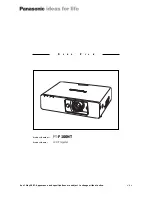
Section 2: Installation and Setup
Roadie HD+35K User Manual
2-9
020-100340-02 Rev. 1 (01-2010)
Displaying both “Flat" and "Scope"
As an example, two standard types of displays (flat and scope) differ in their width-to-height aspect ratio as
shown below:
Figure 2-8 Typical Wide Formats
Achieving either of these displays from a variety of incoming source material (that may or may not be in the
same format) depends on proper settings in the projector as well as certain room conditions.
Projector Variables: Electronic and Anamorphic Resizing
The native resolution of the projector (1.89) closely matches the aspect ratio of "flat" source material (1.85).
Wider scope material, however, may be "squeezed" electronically that is, it is distorted into a narrower area
(characterized by unusually thin people) so that its pixels can then be stretched horizontally through the
anamorphic lens to regain the full and properly proportioned 2.39 display. This optical widening can stretch the
image by approximately 25%. See
Figure 2-9
.
Figure 2-9 Typical Method for Achieving “Scope”
Masking Options
In order to conveniently present different types of incoming data-for example, flat vs. scope-on a single screen,
you can use physical masking to cover the unused edge(s) of the screen. These movable panels are most
commonly installed along the top edge of the screen, changing the height of the screen, but not its width, and
are most frequently used in permanent installations.
The screen shown in
Figure 2-10
also has a bottom mask:
• Add masks for "scope" displays
• Remove masks for "flat" displays
“Flat” Image
“Scope” Image
Aspect ratio = 1.85
Aspect ratio = 2.39
Normal “Scope” Image
An
am
or
ph
Unused pixels
Screen edge
Содержание Roadie HD+35K
Страница 1: ...Roadie HD 35K U S E R M A N U A L 020 100340 02 ...
Страница 2: ......
Страница 3: ...Roadie HD 35K U S E R M A N U A L 020 100340 02 ...
Страница 66: ......
Страница 160: ......
Страница 166: ......
Страница 182: ......
Страница 190: ......
Страница 191: ......
















































